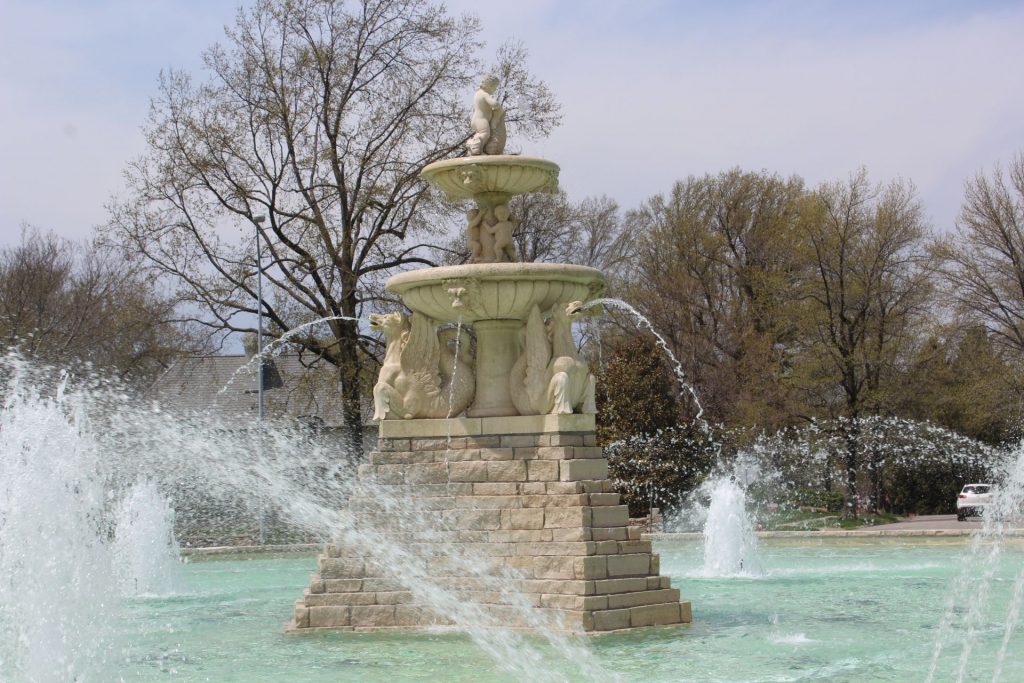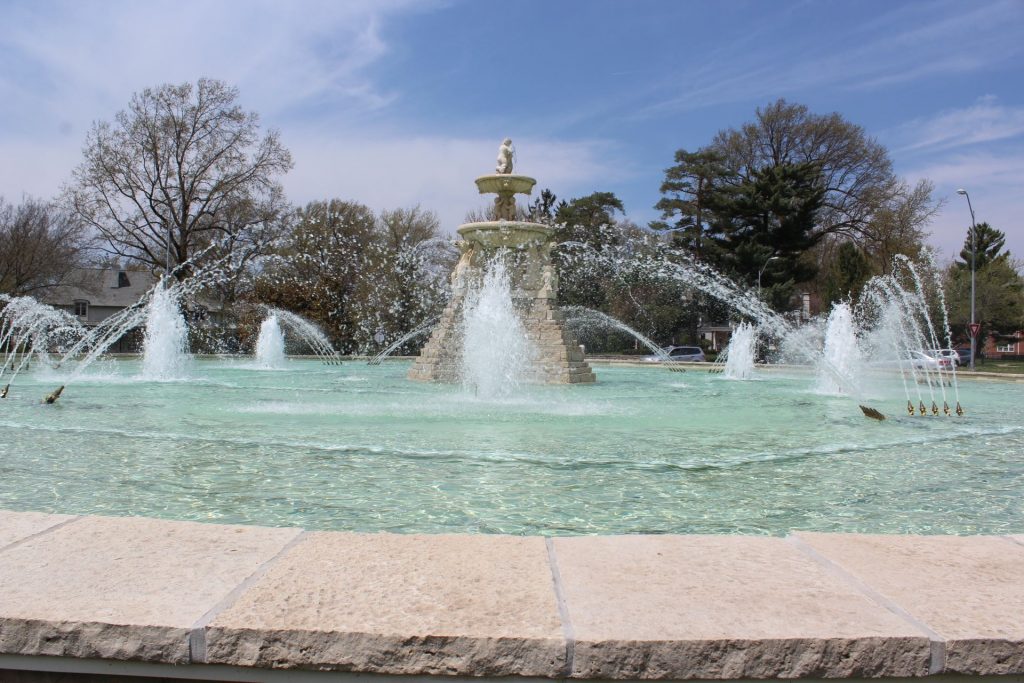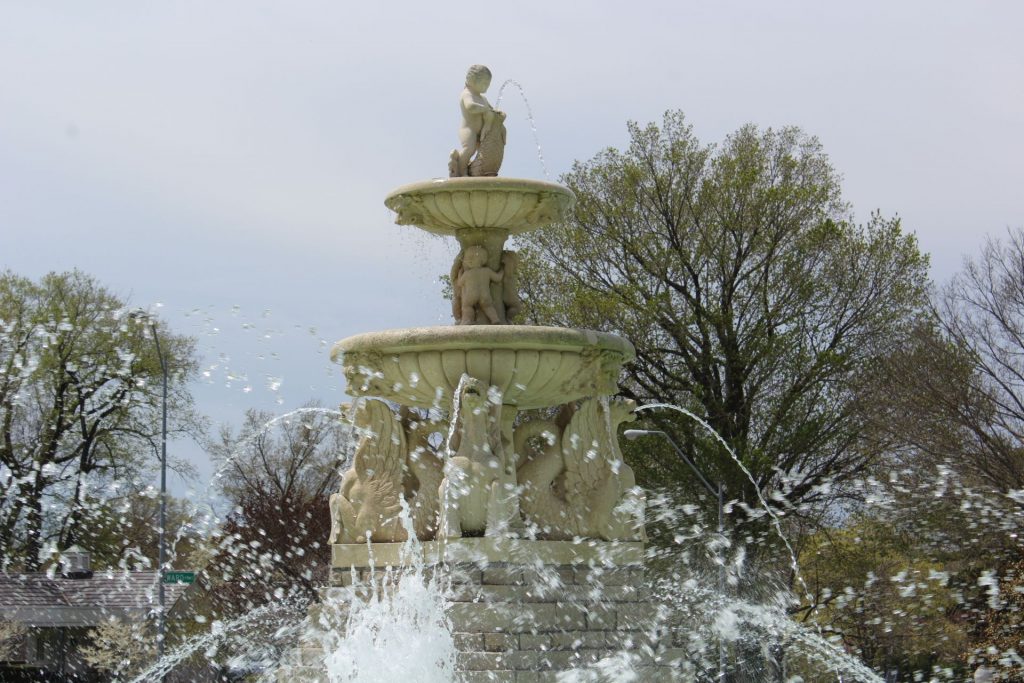The Meyer Circle Sea Horse Fountain has graced Kansas City with its presence for nearly a century. Prior to that time, the original statuary, which was made of Carrera marble and dated from the 17th century, was on display in Venice, Italy. J.C. Nichols, the real estate developer, decided that it should be a gift from the J.C. Nichols Company to the city. The fountain cost $15,000 (equivalent to $226,138 in today’s money). The announcement of the proposed donation was made in 1924, as sections of Ward Parkway (named for Hugh Campbell Ward, a lawyer and the son of Seth Ward, whose farm encompassed much of the area) and Meyer Boulevard (named for August R. Meyer, the first president of the Kansas City Parks Board) were being paved. The fountain was to be placed at Meyer Circle, (also named for August), where the two streets intersected. Edward Buehler Delk was selected as the architect. Edward, who was originally from Philadelphia, had come to Kansas City to help create the Country Club Plaza. J.C. and Edward both had traveled extensively in Europe, and what they saw there was incorporated into Nichols Company projects.

Of Edward’s plan, Sherry Piland and Ellen J. Ugucciono wrote in Fountains of Kansas City: A History and Love Affair:
“Delk’s drawings illustrated three sea horses elevated on a triangular natural stone pyramid. The sea horses, perched at the truncated extensions of the pyramid, were odd mythological beasts with scaly fishlike tails, feathery wings, horse heads, and webbed feet. They formed the base for a fluted saucer which composed the second tier of the fountain. The saucer had a carved lion head spigot at each side, from which spurted a jet of water. The third tier of the fountain consisted of another pedestal supporting an identical saucer equipped with lion head spigots and two small cherubs clinging to the pedestal stem. At the summit of the fountain was another sculptural group depicting a child astride a dolphin.
“Delk indicated that sixteen jets of water would play on the fountain from the basin and water would also issue from the nostrils of the horses and from the mouth of the dolphin that terminated the upper portion of the sculpture.”


Property for the Meyer Circle area was acquired from the J.C. Nichols Company and the Wornall family, as part of a plan for the extension of Ward Parkway, accepted by the City in 1921.
In March 1924, J. C. Nichols presented a “plan for the development of Meyer Circle” to the Park Board. The plan was given to the newly formed Art Commission for their recommendation on the “appropriateness and artistic merit.” The Art Commission members, appointed by the Board of Park Commissioners, were Henry F. Hoit and William Drewin Wright, both architects, and S. Herbert Hare, landscape architect. In October 1924, the Art Commission gave their report to the Park Board, approving the fountain and making suggestions about its elevation, positioning, and curbing.
The J.C. Nichols Company created a pool for the fountain that was 80 feet in diameter, with an outer edge of limestone. The fountain and pool together cost $18,000 ($271,365 by current standards).
Vandalism has taken a toll on the fountain through the years. Even the most light-hearted prank has the potential to cause destruction or injury. It was fortunate that the parking of a battered red tricycle atop the fountain in the early 1960s led to nothing but minor inconvenience for the Parks Department employee assigned to retrieve it. Other situations have been more serious. The cherub with the dolphin that was at the top was stolen in 1961. A fragment was found, but even a $500 reward failed to turn up the rest. It is believed to have been destroyed. In 1966, a cherub holding a serpent was broken in half, and part of it went missing. The damaged piece wasn’t recovered until 1991, after a local couple saw a photo of the fountain in earlier days in an article in the Kansas City Star. They recognized the “lawn ornament” they had purchased at a long-ago rummage sale, and they arranged to return it.
All fountains require ongoing maintenance, and the Sea Horse Fountain is no exception. Advances in technology through the years have led to improvements. For example, in 1966, new equipment made it possible to recirculate the water, as a way to cut costs. A few years earlier, the jets had been redirected to flow near the statuary; previously, the spray had hit the sea horses.


The marble statuary deteriorated as the years passed. The fountain was removed in 1991 and replaced the following year with a replica made from sandstone. The cost was $63,000. According to the Star, the new version, which was made in Italy, included “three sea horses, three cherubs, two bowls, and a dolphin.” The lighting was enhanced in 1992, with 60 light fixtures at the base and fiber optics added at the top.
Almost 25 years after these major renovations, continual flooding caused the Sea Horse Fountain to become inoperable in 2015. At that time, it was clear that the vault, the pump room, and the electrical equipment would all need to be replaced. The price was high – close to $1 million – but leaving the beloved fountain dry was unthinkable. David Fowler volunteered to lead fundraising efforts. A combination of private donations and funding from both the city government and the City of Fountains Foundation made it possible to complete the repairs and create an endowment for future maintenance. A rededication ceremony for the fountain was held on October 25, 2017.
What has remained constant through the decades is the enjoyment of the fountain by visitors and residents. A young man who went there to watch the sun rise after his senior prom in 1927 still savored the experience when he told the Star about it, more than 60 years later. Others favor different times of the day. “The lively spray looks its best in the late afternoon light,” opined Donald Hoffman, the art and architecture critic for the Star, in 1982. He viewed the fountain as being among the top 10 in Kansas City, which is known for having “more fountains than any city but Rome.” Generations of the fountain’s admirers would agree.
Acknowledgment: With special thanks to Ann McFerrin, Archivist at Kansas City Missouri Parks and Recreation, for research and editorial assistance.
For further reading:
- Board of Parks & Recreation Commissioners. History & Dedicatory Monuments of Kansas City. 1987.
- Piland, Sherry and Ellen J. Ugucciono. Fountains of Kansas City: A History and Love Affair. Kansas City, Missouri: City of Fountains Foundation, 1985.
- kcparks.org
- kcfountains.com/fountains
Also featured in the August 22, 2020 issue of The Independent
Photo credit: Bradley Cramer
By Heather N. Paxton